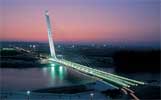
Seville River
The River Guadalquivir has been a central feature of Seville from its earliest beginnings and the topographical element that has had the greatest influence on the city.

The River Guadalquivir, known in the past as the River Betis, is the most important waterway in Andalusia and one of the most important in Spain. It is 650 km long, has a high flow rate and is the only navigable river in Spain on which such an important city as Seville stands.
The source of the river is in the Cordilleras Béticas, in Sierra de Cazorla (more specifically the Gorge of Las Fuentes in the municipal district of Quesada at 1340 m above sea level). In the past, farmers considered the ideal farm to be one situated near the sea or a navigable river, so that the produce could be easily transported to where it was to be sold. Otherwise, the produce had to transported by road to the nearest port. It is a well-known fact that it used to be much quicker and economical to transport goods by river or sea than overland, particularly in the case of bulky loads, such as agricultural produce.
A sunny day or a spring evening is the ideal time to take a walk along the Guadalquivir, following the course of the river through the city of Seville. The effects of the irregular flow of the river, subject to sudden and violent freshets and the pulsing of the tides, and the complex sandy river bed have significantly marked the history of the city.
It was in Roman times that the river began to play an increasingly important role in maritime transport, as it was navigable from the Atlantic Ocean to the inland area of the region of Andalusia, specifically to the port of Seville. Later, the Moors who settled in the area were amazed at its grandeur and gave it its current name, Guadalquivir. They continued to use it as an important trade route. In the 17th century the port of Seville declined in importance and splendour, although its influence on the landscape, people and traditions of the city has survived to the present day.
There are now boat trips along the Guadalquivir from the city centre to the mouth of the river near the wonderful Doñana Nature Park. Shorter boat rides from one end of Seville to the other provide a different view of its monuments.

The river is an exceptional witness to the history of Seville. In the 15th century all the ships bringing treasures from the New World berthed at the Port of Seville. At the end of the 19th century and on the occasion of the 1929 Ibero-American Exhibition, the Guadalquivir was the undisputed centrepiece of urban development. The new bridges built across the river figured as some of the most striking features of the renovation of the city carried out for the 1992 Seville Universal Exposition and to meet the challenges of the 21st century.
The construction of new infrastructures for the 1992 Exposition included numerous bridges. One of these was Alamillo Bridge, designed by the great architect Santiago Calatrava. It is around 140 m high and is "suspended" by cables forming an obtuse angle. The original project included a similar bridge facing the opposite direction on the other bank, but the idea had to be scrapped for financial reasons. One of the cables caught fire a few days before the bridge was due to undergo load testing. The top of the structure resembles a horse's head, and its eye serves as a vantage point.
Bridge of the Barqueta. On the site where the old pier crossing the Guadalquivir was located, the Pasarela de Barqueta-Mapfre was constructed. Planned by José Arenas de Pablo and J. Pantaleón Prieto, and consisting of only an archway and a line of pendulums. This construction is one of the principle entrances to the Expo site. Pasarela de la Cartuja is a pedestrian bridge that is 172 m long, a record length for a bridge supported only at the ends.
Cristo de la Expiración Bridge is also known as Cachorro Bridge, because it was built over the piece of land cutting off the river known as the Corta de Chapina, which was then removed to let the river flow under it. Traffic over the bridge is very busy, as it is part of the main route for the A- 92 from Seville to Huelva. Delicias Bridge is a drawbridge built to replace Alfonso XIII Bridge, better known as the Iron Bridge (Puente de Hierro) and a legacy of the 1929 Exhibition. It is on one of the main routes connecting Seville and the Aljarafe area.
Located near Tablada and Los Remedios, it has helped to solve some of the traffic problems endured by those living in these neighbourhoods and in La Raza, La Palmera and Reina Mercedes.
The Quinto Centenario Bridge is also known as "San Paquito Bridge" owing to its similarity to the Golden Gate in San Francisco. It has three lanes in each direction and a reversible lane. When it was built, it was the longest bridge in Spain. It is considered part of the SE-30 ring road as it links the Cadiz motorway junction to Tablada. It is high enough for the passage of large ships.
Seville Spain information



